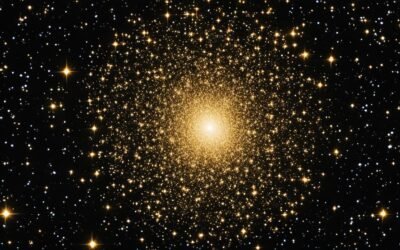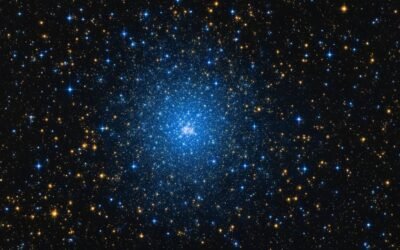Welcome to the captivating world of celestial objects! In this article, we will take you on a journey to discover Messier 71, a mesmerizing globular cluster located in the Sagittarius constellation. Known for its unique properties and historical significance, Messier 71 offers a wealth of exploration and discovery in the realm of deep-sky objects.
Also referred to as the Messier 71 cluster, this celestial gem was first discovered by Philippe Loys de Chéseaux in 1745 and later included in Charles Messier’s catalog of non-comet-like objects in 1780. Situated approximately 13,000 light years away from Earth, this globular cluster spans an impressive diameter of 27 light-years.
Key Takeaways:
- Messier 71 is a globular cluster located in the Sagittarius constellation.
- It was discovered in 1745 by Philippe Loys de Chéseaux and cataloged by Charles Messier in 1780.
- M71 is approximately 13,000 light years away from Earth and spans 27 light-years in diameter.
- It is classified as a very loosely concentrated globular cluster and contains over 20,000 stars.
- The best time to observe M71 is during the summer months.
Discovering Messier 71
Messier 71, a captivating celestial object, was initially discovered by the Swiss astronomer Philippe Loys de Chéseaux in 1745. This remarkable globular cluster later caught the attention of Charles Messier, who included it in his catalog of non-comet-like objects in 1780.
“Messier 71 is an intriguing find, exhibiting fascinating characteristics that distinguish it from other celestial objects,” remarked Philippe Loys de Chéseaux.
Initially mistaken for a densely packed open cluster, subsequent observations and in-depth analysis, including photometric data, revealed its true identity as a globular cluster. Nestled within the small Sagitta constellation, Messier 71 continues to enthrall astronomers and stargazers alike with its enigmatic nature.
Location and Appearance of Messier 71
Messier 71, also known as M71 or NGC 6838, is situated in the small northern constellation Sagitta. It can be found within the Summer Triangle asterism, which consists of the bright stars Deneb, Altair, and Vega. To observe Messier 71, all you need is a pair of binoculars. When you gaze through them, you will see a hazy patch of light, indicating the presence of this celestial object.
For a more detailed view, small telescopes are recommended. With the help of a small telescope, you will be able to observe the cluster’s individual stars and discern the intricate details of its structure. This deeper observation allows for a truly mesmerizing experience, as you witness the beauty of the stars within M71.
The best time to observe Messier 71 is during the summer months. The clear summer skies provide an ideal backdrop for stargazing and exploring this fascinating globular cluster. So, grab your binoculars or small telescopes and embark on an unforgettable summer observation of Messier 71.
The Location and Appearance of Messier 71 in Summary:
| Location | Appearance | Observation Tools | Best Time |
|---|---|---|---|
| Sagitta constellation | Hazy patch of light | Binoculars and small telescopes | Summer months |
Characteristics and Composition of Messier 71
Messier 71 is known for its unique properties that set it apart from other globular clusters. Unlike most globular clusters, M71 has a relatively low density and lacks the dense central compression commonly observed. This characteristic makes it an intriguing object for astronomers to study and understand further.
The stars within Messier 71 exhibit a higher metallicity compared to other ancient globular clusters. Metallicity refers to the abundance of elements heavier than hydrogen and helium in a star. This higher metallicity suggests that the stars within M71 have a different chemical composition, possibly indicating a different origin or evolution.
Another notable characteristic of Messier 71 is its absence of RR Lyrae variables. RR Lyrae variables are pulsating stars commonly found in globular clusters. Their absence in M71 adds to its unique nature, providing further opportunities for investigation and exploration.
Messier 71 has a mass of approximately 17,000 times that of the Sun. This substantial mass contributes to its ability to maintain its gravitational cohesion over billions of years. Additionally, the luminosity of M71 is estimated to be about 13,200 times that of the Sun, further highlighting its brilliance and significance.
With an estimated age of 9 to 10 billion years, Messier 71 has witnessed significant cosmic events throughout its existence. Its radius spans 27 light years, encompassing a vast region of space filled with thousands of stars.
The composition and characteristics of Messier 71 provide valuable insights into the formation and evolution of globular clusters. By studying this unique cluster, astronomers deepen their understanding of the complexities of the universe and the diverse structures it contains.
| Property | Value |
|---|---|
| Star Density | Relatively low density, lacking a central compression |
| Metallicity | Higher metallicity compared to other ancient globular clusters |
| RR Lyrae Variables | Absence of RR Lyrae variables |
| Mass | Approximately 17,000 solar masses |
| Luminosity | Approximately 13,200 times that of the Sun |
| Age | 9 to 10 billion years |
| Radius | 27 light years |
Exploration of Messier 71
Messier 71, also known as M71, has been the subject of extensive exploration utilizing various observational techniques. The renowned Hubble Space Telescope has played a crucial role in capturing detailed images of this mesmerizing cluster, offering a glimpse into its intricate structure and composition (Image source: https://seowriting.ai/32_6.png).
Researchers have focused on studying the variability of stars within Messier 71, uncovering valuable insights into the nature of pulsating variable stars and their behavior within this globular cluster. These investigations have also involved the observation of X-ray sources within M71, shedding light on the celestial phenomena occurring within its stellar population. Such endeavors contribute to a deeper understanding of the properties and evolution of globular clusters.
Additionally, the exploration of Messier 71 extends beyond traditional observation techniques. Advanced studies and detailed analysis have revealed fascinating aspects of this cluster, such as star cluster studies, star variability, and the unique pulsating stars that call M71 their home.
Enhanced knowledge gained from X-ray observations provides crucial information about the internal dynamics of globular clusters and the fascinating phenomena occurring within them.
In summary, the comprehensive exploration of Messier 71, aided by the groundbreaking capabilities of the Hubble Space Telescope and other advanced observation methods, has allowed for a deeper understanding of star cluster studies, star variability, and the unique properties of pulsating stars within this stunning globular cluster.
Historical Observations and Classification of Messier 71
Messier 71, also known as M71 or NGC 6838, has a fascinating history of observations and classification. Initially, prominent astronomers, including Harlow Shapley, believed it to be a densely packed open cluster.
However, further research and spectral analysis conducted over the years unveiled the true nature of M71 as a loosely concentrated globular cluster. This inconclusive research and the challenges it posed reflect the complex and unique properties of this celestial object.
“The classification of Messier 71 has evolved as we delve deeper into our understanding of its composition and structure.”
Over time, advancements in astronomical techniques and technologies have shed more light on the nature of M71, helping astronomers classify it accurately as a globular cluster.
Through spectral analysis, researchers have gained insights into the cluster’s composition, providing valuable information about its stars, metallicity, and other distinctive features.
Notable Discoveries
Harlow Shapley’s initial classification and subsequent observations of M71 have paved the way for further exploration and discoveries within this enigmatic cluster.
- Researchers have identified millisecond pulsars within M71, thanks to the detailed observations made using the Chandra X-Ray Observatory.
- Studies have revealed the presence of pulsating variable stars, including those of the SX Phoenicis type, offering invaluable insights into the cluster’s dynamics.
- Inconclusive research on the nature of stellar winds suggests that M71 may witness the ejection of white dwarf stars, providing intriguing avenues for future study.
These exceptional discoveries illustrate the evolving nature of our understanding of Messier 71 and the ongoing quest to unravel its mysteries.
Summary and Future Prospects
As research on Messier 71 continues, we can expect further advancements in our knowledge of its classification, composition, and unique properties.
“The enigmatic nature of Messier 71 fuels our desire to explore and learn more about this captivating globular cluster.”
By combining historical observations, spectral analysis, and cutting-edge technologies, astronomers are gradually piecing together the puzzle of Messier 71, contributing to our broader understanding of globular clusters and the universe.
| Historical Observations and Classification of Messier 71 |
|---|
 |
Notable Discoveries in Messier 71
Messier 71, the unique globular cluster located in the Sagitta constellation, has been the site of several remarkable astronomical discoveries. Through careful observation and advanced technology, astronomers have made significant findings within this celestial object.
Millisecond Pulsars
Using the powerful capabilities of the Chandra X-Ray Observatory, astronomers have identified millisecond pulsars within Messier 71. These rapidly rotating neutron stars emit beams of electromagnetic radiation, appearing as precise and regular pulses. The discovery of millisecond pulsars in M71 provides valuable insights into the composition and dynamics of this globular cluster.
Eclipsing Binary Systems
Observations of Messier 71 have revealed the presence of eclipsing binary systems. These fascinating phenomena occur when two stars orbit each other in such a way that their orbital plane aligns with our line of sight. As a result, the brightness of the system appears to periodically decrease when one star passes in front of the other. The identification of eclipsing binary systems in M71 contributes to our understanding of stellar evolution and binary star dynamics.
SX Phoenicis Type Pulsating Star
Within Messier 71, astronomers have also observed SX Phoenicis type pulsating stars. These are variable stars that undergo pulsations in brightness due to the compression and expansion of their outer layers. The study of pulsating stars within M71 enables astronomers to investigate the internal structure and evolutionary stages of stars within this globular cluster.
White Dwarf Ejections
Studies have suggested that Messier 71 may eject white dwarf stars due to the asymmetry of stellar winds. The dynamics within globular clusters can lead to interactions between stars, resulting in the ejection of white dwarfs. This phenomenon provides unique insights into the complex interactions and evolutionary processes occurring within M71.
These notable discoveries in Messier 71 demonstrate the importance of studying globular clusters like this. The exploration of millisecond pulsars, eclipsing binary systems, SX Phoenicis pulsating stars, and white dwarf ejections within M71 contributes to our understanding of stellar evolution, cluster dynamics, and the intricate nature of the universe.
Observing Messier 71
Messier 71 is a captivating object for sky observers. Whether you are a beginner or an experienced stargazer, observing M71 can offer a fascinating glimpse into the wonders of the universe. Here are some tips to enhance your sky observation experience:
1. Use Binoculars for a Clear View
To start observing Messier 71, grab a pair of binoculars. Point them towards the designated area in the Sagitta constellation, and you’ll be able to spot a hazy patch of light. Binoculars provide a wide field of view, allowing you to appreciate the overall structure of the cluster.
2. Upgrade to a Medium-Sized Telescope
If you want to see more details and individual stars within Messier 71, consider using a medium-sized telescope. It will offer higher magnification and better resolution, revealing the beauty of this globular cluster. Explore the intricacies of the stellar components and observe the different colors and brightness levels of the stars.
3. Observe During the Summer Months
The best time to observe Messier 71 is during the summer months. The cluster is visible in the night sky, making it easier to locate and observe. Take advantage of clear, warm nights when the Sagitta constellation is well-positioned for observation. Plan your stargazing sessions accordingly to optimize your experience.

“Observing Messier 71 with binoculars can reveal its hazy beauty, while a medium-sized telescope allows you to explore its intricate details and individual stars.”
Observing Messier 71 can be a rewarding experience as you delve into the mysteries of this globular cluster. Whether you are a casual observer or a dedicated astronomer, take the time to appreciate the wonders of the universe right above our heads.
Historical Significance of Messier 71
Messier 71 holds great historical significance as one of the celestial objects cataloged by the renowned astronomer Charles Messier. The inclusion of Messier 71 in his astronomical catalog highlights its importance to historical astronomers and deep sky enthusiasts alike. The study of Messier 71 and other objects in the Messier catalog has significantly contributed to our understanding of the universe and the enduring legacy of Charles Messier.
Charles Messier, a French astronomer, compiled a comprehensive catalog of non-comet-like objects in the night sky during the 18th century. His catalog consisted of various deep sky objects, including nebulae, galaxies, and globular clusters such as Messier 71. Messier’s work was instrumental in advancing the field of astronomy and paving the way for future exploration.
“The study of Messier 71 and other objects in Charles Messier’s catalog has greatly contributed to our knowledge of the universe and the lasting legacy of this remarkable astronomer.”
Notable Contributions of the Messier Catalog:
- Provided a comprehensive list of deep sky objects for astronomers to observe and study
- Cataloged objects that were frequently mistaken for comets, aiding in the identification of true comets
- Promoted the exploration of deep sky objects beyond the Milky Way, expanding our understanding of the cosmos
- Facilitated the classification and categorization of celestial objects, assisting astronomers in organizing their observations
Charles Messier’s dedication to documenting and cataloging deep sky objects, including Messier 71, has left an indelible mark on the field of astronomy. His legacy continues to inspire astronomers and sky observers to explore and unravel the mysteries of the universe.
| Contributions of Messier’s Catalog | Impact |
|---|---|
| Comprehensive list of deep sky objects | Expanded our knowledge of celestial bodies beyond our galaxy |
| Facilitated the identification of true comets | Prevented confusion between comets and other celestial phenomena |
| Organized classification of celestial objects | Streamlined astronomical observations and research |
| Promoted deep sky exploration | Inspired astronomers to study objects beyond our immediate surroundings |
Conclusion
Messier 71 is an extraordinary globular cluster that resides in the Sagitta constellation. With its unconventional properties and rich historical significance, this celestial object has captured the fascination of astronomers and sky observers alike. The cluster’s unique composition, variation in its stellar population, and noteworthy discoveries within its confines have provided invaluable insights into the nature and evolution of celestial bodies. By exploring Messier 71, you embark on a journey to unravel the mysteries of the universe and delve into the wonders of our cosmos.
As one gazes upon Messier 71, its captivating features come to life. This globular cluster grants us a glimpse into the intricate web of stars that dot our night sky. Its alluring properties, including low density and distinct lack of dense central compression, set it apart from other ancient globular clusters. With a higher metallicity than other clusters of its age, Messier 71 stands as an enigmatic celestial treasure waiting to be deciphered.
The study of Messier 71 has led to remarkable celestial discoveries. Researchers have used advanced observational techniques, including the Hubble Space Telescope, to capture detailed images that reveal the cluster’s intricate structure. These images, in combination with studies on the variability of stars within Messier 71, have deepened our understanding of pulsating variable stars and X-ray sources. Moreover, notable findings such as millisecond pulsars and ejecting white dwarf stars highlight the scientific importance of this globular cluster and the wealth of knowledge it contributes to our understanding of the universe.
FAQ
What is Messier 71?
Messier 71, also known as M71 or NGC 6838, is a globular cluster located in the Sagittarius constellation. It is a celestial object included in Charles Messier’s catalog of non-comet-like objects.
Who discovered Messier 71?
Messier 71 was discovered by the Swiss astronomer Philippe Loys de Chéseaux in 1745. It was later included in Charles Messier’s catalog in 1780.
Where is Messier 71 located and how does it look?
Messier 71 is located in the Sagittarius constellation. It can be found within the Summer Triangle asterism and appears as a hazy patch of light. With small telescopes, individual stars within the cluster can be resolved.
What are the characteristics and composition of Messier 71?
Messier 71 is a loosely concentrated globular cluster with over 20,000 stars. It has a relatively low density and higher metallicity compared to other ancient globular clusters. It lacks RR Lyrae variables and has a mass of about 17,000 solar masses and a luminosity approximately 13,200 times that of the Sun.
How has Messier 71 been explored?
Messier 71 has been extensively studied using various observational techniques including the Hubble Space Telescope, which has captured detailed images of the cluster. Researchers have also studied the variability of stars within M71, including pulsating variable stars and X-ray sources.
What is the historical significance of Messier 71?
Messier 71 holds historical significance as one of the objects cataloged by Charles Messier. Its inclusion in the Messier catalog highlights its importance to astronomers and deep sky enthusiasts, contributing to our understanding of the universe and the legacy of Charles Messier.
How can I observe Messier 71?
Messier 71 can be observed using binoculars, which will reveal a hazy patch of light. With medium-sized telescopes, the individual stars within the cluster become more apparent. The best time to observe Messier 71 is during the summer months when it is visible in the night sky.
What are some notable discoveries in Messier 71?
Notable discoveries within Messier 71 include the identification of millisecond pulsars using the Chandra X-Ray Observatory. Eclipsing binary systems and pulsating stars of the SX Phoenicis type have also been observed within the cluster. Studies have suggested that Messier 71 may eject white dwarf stars due to the asymmetry of stellar winds.
What is the historical background and classification of Messier 71?
Initially, Messier 71 was thought to be a densely packed open cluster. However, further research and spectral analysis revealed its true nature as a loosely concentrated globular cluster. Its classification has evolved over time, reflecting the challenges in understanding its unique properties.
What is the historical significance of Messier 71?
Messier 71 holds historical significance as one of the objects cataloged by Charles Messier. Its inclusion in the Messier catalog highlights its importance to astronomers and deep sky enthusiasts, contributing to our understanding of the universe and the legacy of Charles Messier.
What are the main features and discoveries related to Messier 71?
Messier 71 is a unique and captivating globular cluster located in the Sagitta constellation. Its unconventional properties, notable discoveries, and historical significance make it an intriguing object of study for astronomers and a must-see for sky observers. Exploring Messier 71 is an opportunity to delve into the wonders of the universe.







